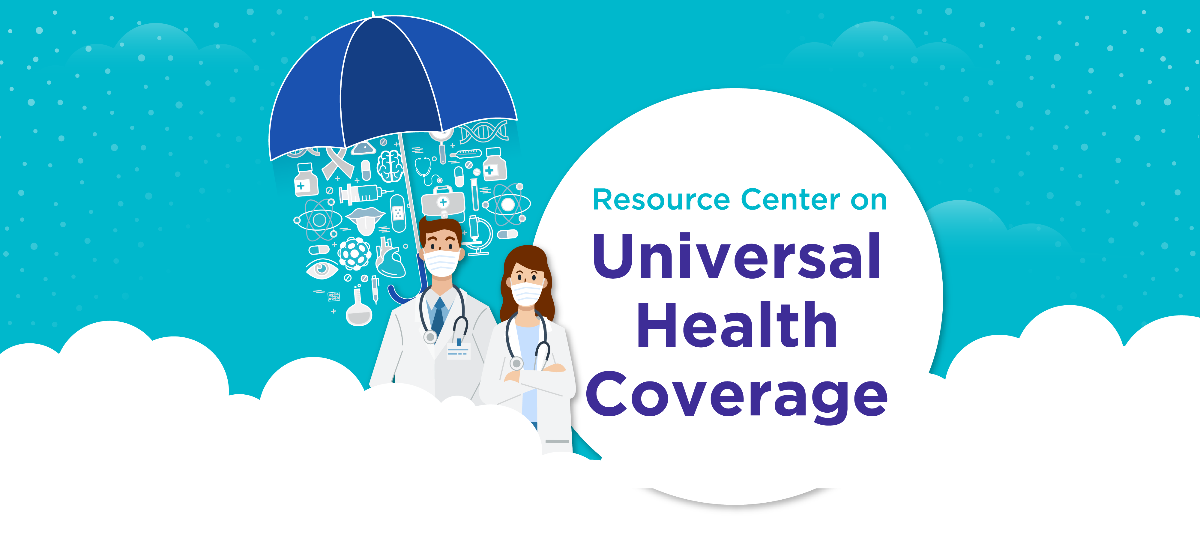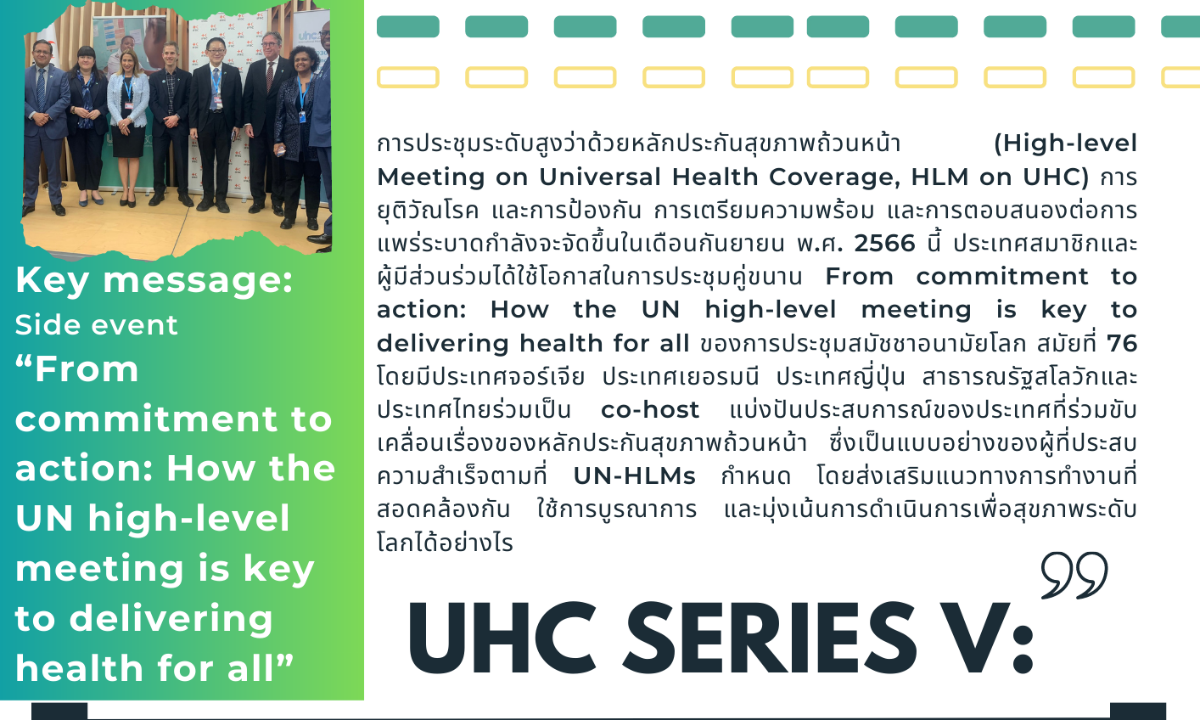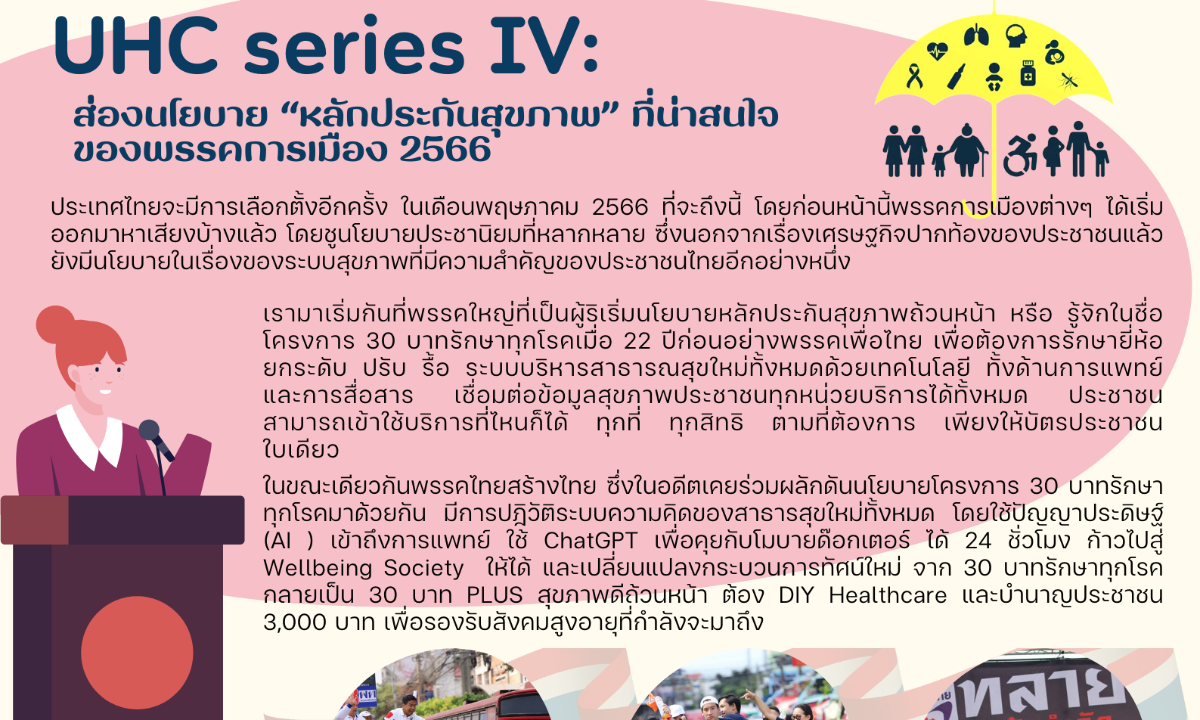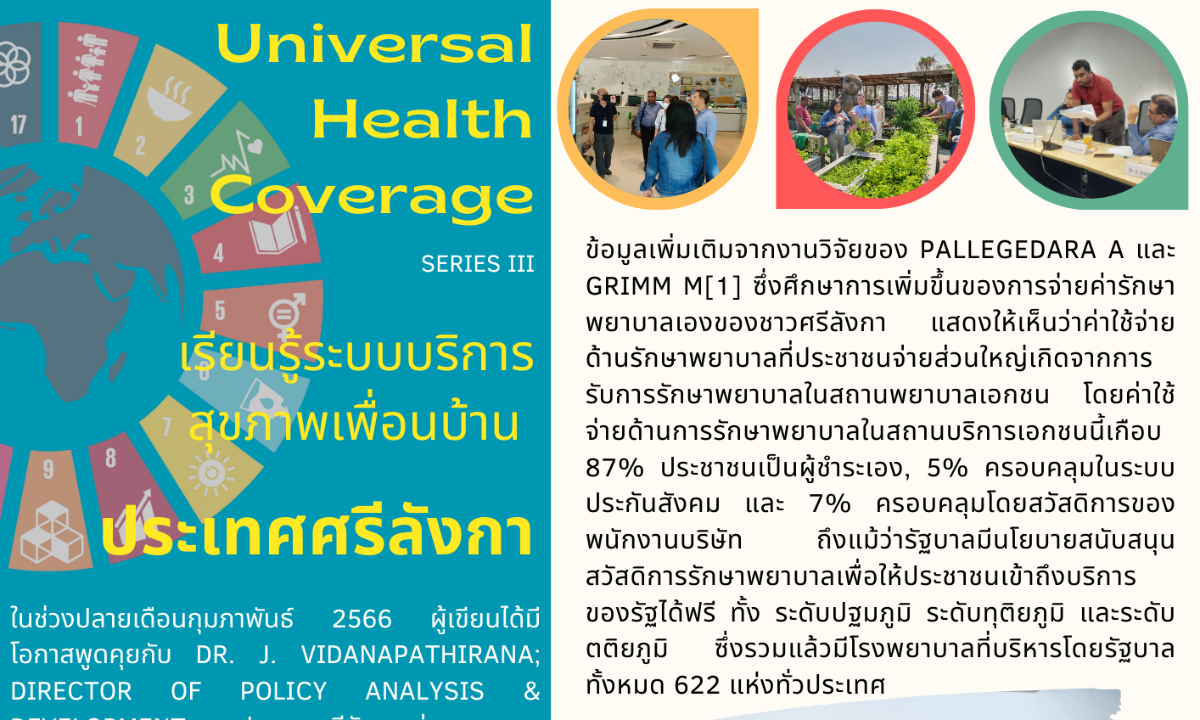
Resource Center on Universal Health Coverage
The Resource Center on Universal Health Coverage (UHC) has been initiated by partners on UHC in Thailand, and then the collaboration extended to international partners. The contributions to developing this Resource Center are from the International Health Policy Program (IHPP), the Country Cooperation Strategy-Global Health Diplomacy (CCS-GHD) and the partnership project for Global Health and Universal Health Coverage (GLO-UHC) and relevant partners.
The Resource Center on UHC is an accessible online platform for learning, exchanging and sharing knowledge of health system and UHC implementation at national and international levels including experiences of Thailand in achieving UHC. On this user-friendly platform, you can find reading materials such as articles, reports, media and other relevant documents about health system and UHC.
We hope this Resource Center will be useful for public and it will be a long-lasting asset of UHC.
Universal Health Coverage (UHC)
Universal health Coverage (UHC) means that all people can access to health services they need, including prevention, promotion, treatment, rehabilitation and palliative care services, without risk of financial hardship. Therefore, UHC is a crucial component of sustainable development and poverty reduction, and a key element in reducing social inequities.
Achieving UHC requires an efficient health system which consists of competent health workers, quality medicines and technologies in order to ensures availability of good-quality health services for the entire population. Additionally, a financing mechanism is required to protect people from impoverishment and incurring financial hardship due to health care costs.
Quality Primary Health Care (PHC) is the cornerstone to achieving UHC around the world. PHC requires community empowerment and social accountability which is linked to education, nutrition as well as water and sanitation. Through the involvement of stakeholders, community participation can help solve health related problems by ensuring measures are relevant, applicable and acceptable in the community’s context.
On 12th December 2012, the United Nations General Assembly (UNGA) adopted the resolution on “global health and foreign policy” (A/RES/67/81), recommending that universal health coverage be considered to be included in the post-2015 development agenda discussions in the context of global health challenges. This adoption further put emphasis on emphasized health as an essential element of international development.
In 2015, all United Nations (UN) Member States committed to the Sustainable Development Goals (SDGs); of which, achieving UHC is one of key health-related targets (SDG3.8).
On 12th December 2017, the UNGA passed the resolution on “global health and foreign policy: addressing the health of the most vulnerable for an inclusive society” (A/RES/72/139) and decided to hold a UN high-level meeting (HLM) on UHC during the 2019 UNGA. The Assembly adopted the resolution on “International Universal Health Coverage Day” (A/RES/72/138), proclaiming 12th December as International Universal Health Coverage Day.
On 23rd September 2019, the UN High Level Meeting on Universal Health Coverage reaffirmed high-level political commitment to UHC and endorsed the most comprehensive political declaration (A/RES/74/2) on UHC to date. The Declaration emphasizes health as a precondition for, and an outcome and indicator of, the social, economic and environmental dimensions of sustainable development. Additionally, the declaration highlights the necessity for the implementation of the 2030 Agenda for Sustainable Development and strongly recommits to the achievement of UHC by 2030.
Global commitment boosts national commitment to achieving UHC. Improving health service coverage and health outcomes depends on the availability, accessibility, and capacity of health workers to deliver quality people-centered integrated care. Investment in quality primary health care is the cornerstone to achieving UHC around the world.
Health Systems and UHC in Thailand
Thailand has achieved Universal Health Coverage (UHC) since 2002, following our 27-year journey of advancing the foundations for UHC, consisting of two stands of development.
First, the development of infrastructure and human resource since the 1970s. Over the past three decades, national policies for rural development scaled up the district health system by reallocating budgets from tertiary care facilities to district facilities. As a result, hospitals were established in every district and health centers in every sub-district, leading to full geographical coverage of public health facilities, particularly in rural areas. To effectively function, health facilities required an adequate number of health workforce. Therefore, during the same period, to retain health professionals in the system, Thailand applied mandatory rural services, requiring all new medicine graduates to work in public rural facilities for three years. This requirement later expanded to other health professionals, namely dentists, pharmacists and nurses. Other strategies were also applied, which was Ministry of Public Health established nursing and public health institutions to boost the production of locally recruited health professionals to work in their hometown. Additionally, financial incentives such as hardship allowances and other non-financial incentives (e.g. housing benefits) were allocated to health professionals in rural areas. With good access to health facilities run by competent and committed health workforce, peoples place their trust in public health services at the district level.
The second stand of development was financial risk protection. Back in the 1970s when Thailand had limited financial resources, the government prioritized financial risk protection to those in need first. The low-income scheme targeted those living under the poverty line and allowed access to free health services. Later, the scheme incorporated other vulnerable groups, namely the elderly, children and disabled people. In parallel, separate schemes were established - the Civil Servant Medical Benefit Scheme (CSMBS) for civil servants and their dependents in late 1970s, and the Social Health Insurance (SHI) scheme for formal sector employees in 1990. However, together with the existing schemes, 30% of Thailand’s population remained uninsured. As a result, in 2001, the government established the Universal Coverage Scheme or UC Scheme (USC) which incorporated the populations previously covered under the low-income scheme and additionally extended coverage to the uninsured population. This led to the achievement of UHC in 2002.
Currently, the majority of Thai population in Thailand benefits from financial risk protection through one of the three public health insurance schemes, each of which has been separately managed and financed with a harmonized benefits package across three schemes as follows:
1. The Civil Servants Medical Benefit Scheme, managed by the Ministry of Finance, covers a population of 6 million civil servants and their dependents including parents, spouse and up to three children.
2. The Social Health Insurance, managed by Ministry of Labor, covers a population of 11 million employees in formal sector, but funded through a tripartite contribution from employer, employee and government.
3. The Universal Coverage Scheme, managed the National Health Security Office and tax financed, covers 74% of the remaining populations including poor persons, vulnerable group and uninsured population.
The key success factors in achieving UHC in Thailand include:
- Strong political will and commitment reflected by continued policies to develop full coverage of health facilities and extend financial risk protection to all.
- Access to functioning health facilities (e.g., health centers and district hospitals) with availability of competent health workforce and medicines in which people can place their trust.
- Adequacy and sustainability of government budget for health and funding for all of the three public insurance schemes.
However, Thailand still faces a number of challenges due to societal and population dynamics, leading to difficulties in tackling social determinants of health, adapting to an ageing society, and providing PHC in urban settings.
Highlights

31 May 2023
UHC series V: Key message จากการประชุมคู่ขนาน “From commitment to action: How the UN high-level meeting is key to delivering health for all”
Read More

UHC series IV: ส่องนโยบาย “หลักประกันสุขภาพ” ที่น่าสนใจของพรรคการเมือง 2566
18 April 2023
UHC series IV: ส่องนโยบาย “หลักประกันสุขภาพ” ที่น่าสนใจของพรรคการเมือง 2566
Read More

เรียนรู้ระบบบริการสุขภาพเพื่อนบ้าน ประเทศศรีลังกา
01 March 2023
UHC series III: เรียนรู้ระบบบริการสุขภาพเพื่อนบ้าน ประเทศศรีลังกา
Read More
